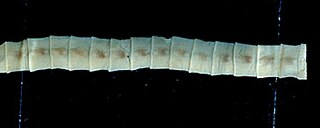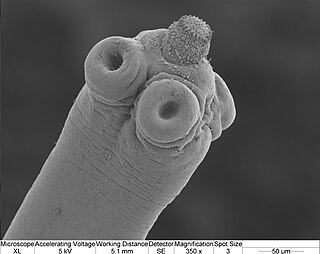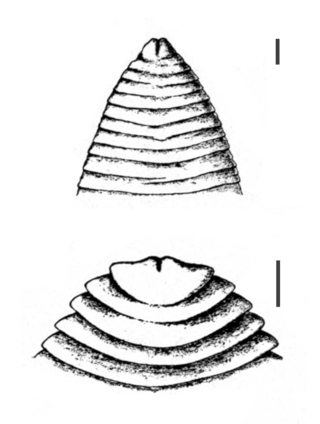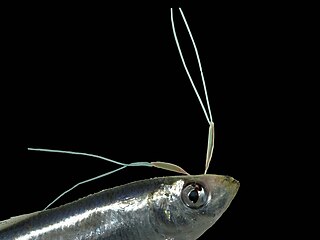
Diphyllobothrium is a genus of tapeworms which can cause diphyllobothriasis in humans through consumption of raw or undercooked fish. The principal species causing diphyllobothriasis is D. latum, known as the broad or fish tapeworm, or broad fish tapeworm. D. latum is a pseudophyllid cestode that infects fish and mammals. D. latum is native to Scandinavia, western Russia, and the Baltics, though it is now also present in North America, especially the Pacific Northwest. In Far East Russia, D. klebanovskii, having Pacific salmon as its second intermediate host, was identified.

Pseudophyllid cestodes are tapeworms with multiple "segments" (proglottids) and two bothria or "sucking grooves" as adults. Proglottids are identifiably pseudophyllid as the genital pore and uterine pore are located on the mid-ventral surface, and the ovary is bilobed ("dumbbell-shaped").
Spirometra is a genus of pseudophyllid cestodes that reproduce in canines and felines, but can also cause pathology in humans if infected. As an adult, this tapeworm lives in the small intestine of its definitive host and produces eggs that pass with the animal's feces. When the eggs reach water, the eggs hatch into coracidia which are eaten by copepods. The copepods are eaten by a second intermediate host to continue the life cycle. Humans can become infected if they accidentally eat frog legs or fish with the plerocercoid stage encysted in the muscle. In humans, an infection of Spirometra is termed sparganosis.

Eucestoda, commonly referred to as tapeworms, is the larger of the two subclasses of flatworms in the class Cestoda. Larvae have six posterior hooks on the scolex (head), in contrast to the ten-hooked Cestodaria. All tapeworms are endoparasites of vertebrates, living in the digestive tract or related ducts. Examples are the pork tapeworm with a human definitive host, and pigs as the secondary host, and Moniezia expansa, the definitive hosts of which are ruminants.
Spirometra erinaceieuropaei is a parasitic tapeworm that infects domestic animals and humans. The medical term for this infection in humans and other animals is sparganosis. Morphologically, these worms are similar to other worms in the genus Spirometra. They have a long body consisting of three sections: the scolex, the neck, and the strobilia. They have a complex life cycle that consists of three hosts, and can live in varying environments and bodily tissues. Humans can contract this parasite in three main ways. Historically, humans are considered a paratenic host; however, the first case of an adult S. erinaceieuropaei infection in humans was reported in 2017. Spirometra tapeworms exist worldwide and infection is common in animals, but S. erinaceieuropaei infections are rare in humans. Treatment for infection typically includes surgical removal and anti-worm medication.
Sparganosis is a parasitic infection caused by the plerocercoid larvae of the genus Spirometra including S. mansoni, S. ranarum, S. mansonoides and S. erinacei. It was first described by Patrick Manson in 1882, and the first human case was reported by Charles Wardell Stiles from Florida in 1908. The infection is transmitted by ingestion of contaminated water, ingestion of a second intermediate host such as a frog or snake, or contact between a second intermediate host and an open wound or mucous membrane. Humans are the accidental hosts in the life cycle, while dogs, cats, and other mammals are definitive hosts. Copepods are the first intermediate hosts, and various amphibians and reptiles are second intermediate hosts.

Schistocephalus solidus is a tapeworm of fish, fish-eating birds and rodents. This hermaphroditic parasite belongs to the Eucestoda subclass, of class Cestoda. This species has been used to demonstrate that cross-fertilization produces a higher infective success rate than self-fertilization.

Cestoda is a class of parasitic worms in the flatworm phylum (Platyhelminthes). Most of the species—and the best-known—are those in the subclass Eucestoda; they are ribbon-like worms as adults, known as tapeworms. Their bodies consist of many similar units known as proglottids—essentially packages of eggs which are regularly shed into the environment to infect other organisms. Species of the other subclass, Cestodaria, are mainly fish infecting parasites.
Diphyllobothrium mansonoides is a species of tapeworm (cestodes) that is endemic to North America. Infection with D. mansonoides in humans can result in sparganosis. Justus F. Mueller first reported this organism in 1935. D. mansonoides is similar to D. latum and Spirometra erinacei. When the organism was discovered, scientist did not know if D. mansonoides and S. erinacei were separate species. PCR analysis of the two worms has shown the two to be separate but closely related organisms.

Like humans and other animals, fish suffer from diseases and parasites. Fish defences against disease are specific and non-specific. Non-specific defences include skin and scales, as well as the mucus layer secreted by the epidermis that traps microorganisms and inhibits their growth. If pathogens breach these defences, fish can develop inflammatory responses that increase the flow of blood to infected areas and deliver white blood cells that attempt to destroy the pathogens.
Bothriocephalus acheilognathi, also known as the Asian tapeworm, is a freshwater fish parasite that originated from China and Eastern Russia. It is a generalized parasite that affects a wide variety of fish hosts, particularly cyprinids, contributing to its overall success.

Hymenolepis microstoma, also known as the rodent tapeworm, is an intestinal dwelling parasite. Adult worms live in the bile duct and small intestines of mice and rats, and larvae metamorphose in the haemocoel of beetles. It belongs to the genus Hymenolepis; tapeworms that cause hymenolepiasis. H. microstoma is prevalent in rodents worldwide, but rarely infects humans.

Ligula intestinalis is a tapeworm of fish, fish-eating birds and copepods, with species from each group featuring in its complex life cycle. Ligula intestinalis is a parasite that changes its intermediate host's behavior to become more vulnerable to its predators. In this case, Ligula intestinalis uses copepods and cyprinid fish as their intermediate host and develops inside of them to get to its final destination which is fish-eating birds. Plerocercoids, Ligula intestinalis larva, influence secondary intermediate hosts’ behavior, health, and fecundity. Additionally, Ligula intestinalis can cause fish-eating birds' gonads to remain undeveloped.
The procercoid is the second larval stage of some tapeworms, which typically develops inside of copepods following their ingestion of the coracidium parasite structure that contains the larval oncosphere. The flatworm in this stage is not enclosed in a protective cyst, but is infectious to the next intermediate host. Procercoids resemble their adult forms in pathways of energy metabolism. They are basically anaerobic, lacking a complete Krebs cycle, and rely on glycolysis.

Lernaeenicus sprattae is a species of copepod in the family Pennellidae. It is a parasite of the European sprat and certain other fish and is sometimes known as the sprat eye-maggot.

Contracaecum is a genus of parasitic nematodes from the family Anisakidae. These nematodes are parasites of warm-blooded, fish eating animals, i.e. mammals and birds, as sexually mature adults. The eggs and the successive stages of their larvae use invertebrates and increasing size classes of fishes as intermediate hosts. It is the only genus in the family Anisakidae which can infect terrestrial, marine and freshwater animals.
Enteromyxum scophthalmi is a species of parasitic myxozoan, a pathogen of fish. It is an intestinal parasite of the turbot and can cause outbreaks of disease in farmed fish. It causes a cachectic syndrome characterised by loss of weight, muscle atrophy, weakness and fatigue.

Diphyllobothrium dendriticum is a large pseudophyllid cestode of the family Diphyllobothriidae.

Cat worm infections, the infection of cats (Felidae) with parasitic worms, occur frequently. Most worm species occur worldwide in both domestic and other cats, but there are regional, species and lifestyle differences in the frequency of infestation. According to the classification of the corresponding parasites in the zoological system, infections can be divided into those caused by nematode and flatworms - in the case of the latter, mainly cestoda and trematoda - while other strains are of no veterinary significance. While threadworms usually do not require an intermediate host for their reproduction, the development cycle of flatworms always proceeds via alternate hosts.









